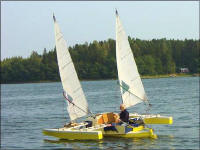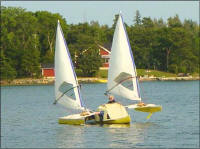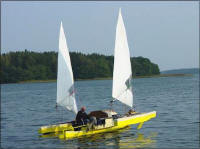Simpler sailing
It is about time to realize that I am getting
old. It is now more than fifty years since I learnt to row and more
than twenty-five years since I started to sail multihulls. It is
also more than twenty years since I met my wife and we spent several
summers sailing a big catamaran in the archipelago between Sweden and
Finland. Our love for this archipelago led to purchase of a seaside
homestead on the island of Veddoe.
Then my wife found that her love was really to the
land and to the companion animals. I was left with the big
catamaran, which proved to be too much to maintain and handle alone.
The result was that it was replaced by a power boat.
Powerboats have their qualities, but they lack the
feeling of a sail boat. So I started to think of what was
available for an elderly singe-handed sailor in the archipelago.
Windsurfers and beach cats are for young and sporty people. Large
family multihulls cost a lot and require a lot of fast handling as soon as
the going gets rough. Small keel boats are boringly slow and tend to
get stuck on rocks and shoals. Sailing canoes are fascinating, but
require their helmsman to sit on a sliding seat outside the boat.
The smallest possible boat I could think of was a
canoe.
 So
I bought a used canoe and tried to convert it into a proa with two
windsurfing sails and a sewage pipe as a pontoon. The contraption
was put together with some sticks and strings. The best that could
be said about this proa was that it did sail (sometimes) and that it did
not capsize (because the masts went overboard before it capsized) My
conclusion was that proas may have their advantages in the Pacific, but
that shunting is not for sailing among islands in the archipelago. So
I bought a used canoe and tried to convert it into a proa with two
windsurfing sails and a sewage pipe as a pontoon. The contraption
was put together with some sticks and strings. The best that could
be said about this proa was that it did sail (sometimes) and that it did
not capsize (because the masts went overboard before it capsized) My
conclusion was that proas may have their advantages in the Pacific, but
that shunting is not for sailing among islands in the archipelago.
Some rethinking led to a trimaran. I
added another sewage pipe and a rudder. The two windsurfer rigs were
put on the forward outrigger. The boat also got two small leeboards,
one in each pontoon. This time the boat sailed OK, although when it
got some wind, it tended to heel and to take water over the gunwale.
The main hull was still yellow and curved, so the boat was called "Banane".
As simple as possible, but no simpler.
The next step was to make everything as simple as possible and to rebuild
Banane into a "mini cruiser" selecting simple and low cost solutions as
far as possible. The result is not yet totally convincing but holds
good promise. Consequently some of the thinking and the solutions
selected might be of a broader interest. Some design details from
the stem and towards stern:
Stem and bottom. It is strange that so
many commercial boats lack protection for their stem and bottom. The
canoe hull has aluminum strings on the stem and under the bottom.
Good to avoid damage and to make it easy to launch and beach the boat.
Cabin. The cabin was built from the
understanding that the human body does not need more space than what is in
a coffin, as long as you can also sit up. This insight keeps cost
down and makes it possible to build a small cruiser.
Outriggers. As outriggers I used two
aluminum ladders fastened to the sides of the hull (after an idea from the
AYRS, Amateur Yacht Research Society). The ladders were bolted to
fasteners on each side of the hull and to the pontoons.
Rig and stays. On each side of the front
outrigger was placed a mast foot, built from an IKEA
 desk
leg from with wooden fastenings to the ladder. The two windsurfer
rigs were placed in these foots without stays, but each with a sheet which
starts at the mast foot, goes up to the boom and then a couple of times
down and up. The result is that the sheet line also works as a set
of stays for the mast and that it is no problem to sheet the sails without
winches. desk
leg from with wooden fastenings to the ladder. The two windsurfer
rigs were placed in these foots without stays, but each with a sheet which
starts at the mast foot, goes up to the boom and then a couple of times
down and up. The result is that the sheet line also works as a set
of stays for the mast and that it is no problem to sheet the sails without
winches.
Pontoons. Sewage pipes are heavy and
have little buoyancy. The were replaced by pontoons built in Gabon
plywood with wooden reinforcements for fastenings and leeboards.
Leeboards. Leeboards were built from
wooden stringers, glued together. They are angled 45 degrees inwards
in order to give both a lift to the pontoon and a force to prevent leeway.
The are also angled with a five degrees angle of attack, something that is
possible when only one leeboard is in the water at one time.
Rudder. The rudder and the rudder head
were built from wood. Since the rudder is the deepest part of the
boat it is pivoting to get up as soon as the boat hits a rock or when you
sail up onto a beach. The rudder blade is kept down by a rubber rope
to make it go down after you have passed a rock.
Motor. Although few canoes have any
motor, this one has a 2 hp Honda. It has proven to be most useful
after each failed trial sail.
Cost and time. Cost was kept down
through buying some used equipment (canoe hull), through use of some scrap
material (office desk legs) etc. I have not kept a detailed record
of the cost but it seems to add up to something between two and three
thousand US dollars. Building time was about one and a half month of
part time work.
Experiences. As can be seen from the
pictures, the boat sails and goes to windward. It is not yet ready
for racing but I would expect that it will prove to be faster than small
keelboats, about as fast as a "regular sailing canoe" but slower than a
full size multihull cruiser or a beach cat.
 At
present tacking is a problem. The boat has so low weight that it has
difficulties to change tack without help with the paddle. I will try
to move the masts a few inches backwards, something that might help. At
present tacking is a problem. The boat has so low weight that it has
difficulties to change tack without help with the paddle. I will try
to move the masts a few inches backwards, something that might help.
Since the boat is much more stable than a windsurfer
board, the masts tend to bend too much and to spill wind. I will try
to reinforce the masts with carbon fiber, something that might help.
The general conclusion is that it will be quite
possible to extend next year's trial sails to some cruises among the
islands.
Last.
Banane is not yet sufficiently developed for me to recommend someone else
to build another. However, if anyone is interested to discuss
details you are welcome to mail me at
iog@toolforsystems.com If there seems to be interest and if
the boats fulfils its promises, I might be back with a more detailed
report on building experiences and maybe also some experience from "mini
cruising".
Ingmar Ogren |